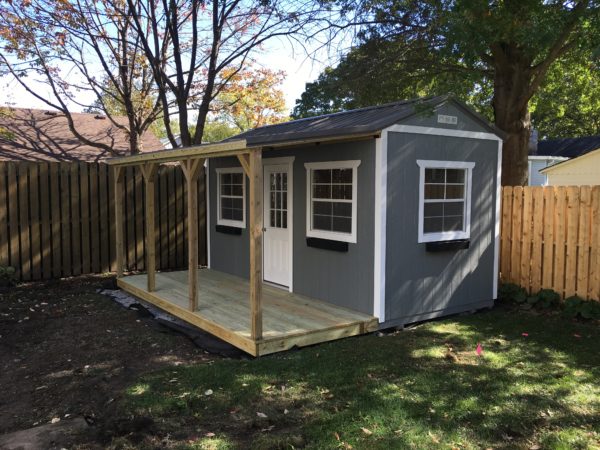A thorough process of evaluating backyard sheds should be utilized before you make your final decision. Your shed is going to be a visible part of your home and yard for the next 15-20 years, and it’s an investment that can improve your property’s aesthetics and your home’s selling appeal.
In this post, we’re going to look at the primary things to consider before you make your purchase. We’ll look at:
- price vs. quality
- design considerations
- blending into the landscape
- shed materials
- foundation and flooring
- and more
Considering all of the uses and benefits you’re going to be getting from your shed, the time spent looking at different types and styles of backyard sheds will be a wise investment.
Price vs. Quality When Buying Backyard Sheds
Knowing how much you’ve budgeted for a new shed will save you a lot of time upfront. Buying a shed is like buying anything that can vary in price by thousands of dollars – you get what you pay for. Yes, it’s wise to stay within your budget, but you don’t want to make your decision on price alone. There are some shed providers that offer financing and rent-to-own options that can make a better quality shed more affordable for you.
Considering the Design
Is you home a colonial style home? Modern? Country-style? You want the style of your backyard shed to be compatible with your home’s style. Something rustic will go well with a country-style home, but not so well with a more modern looking house. If your home has a formal look, you may want a shed with similar features, such as an arched window or door.
If you live in the midwest, you want to consider the seasons, especially winter, when looking at backyard sheds. A shed with a pitched-roof will be much more conducive to snow melting and water running off of it than a flat-roofed shed. And properly gauging the width of the door(s) is critical. How wide is the widest item you’re going to be storing in your shed? Countryside Barn’s shed designer can help you configure your shed to meet your individual needs, there’s no reason to take a cookie-cutter approach.
What Will Your Backyard Shed Be Used For?
The function of your shed is of great importance when you’re evaluating backyard sheds. What is it’s purpose? Do you need a:
- garden shed
- utility shed
- garage or lofted garage
- golf cart storage shed
- man cave / she shed
- artists/writers shed
- “work from home” shed
Talking with an experienced shed design company will ensure that you find a shed that will fit perfectly with it’s intended use.

Choosing the Right Material
Depending upon the physical environment your shed is going to be placed in, as well as the climate it will be exposed to, will make a difference in choosing which material your shed should be constructed from.
If you’re looking for longevity in a shed, wood sheds are very durable. They will require some maintenance to reach their full life-expectancy, but a fresh coat of paint that matches your home’s exterior will have your shed be a visually appealing addition to your property.
Two budget-friendly options are plastic and resin sheds. They are rot-resistant and don’t attract insects. Because they’re light, they can easily be moved around your property, and a good cleaning by hand or using a power washer keeps them looking good.
If you need extra strength and support, metal sheds will fit the bill. While offering a bit of an industrial look, they can withstand harsh weather like wind, rain, and sleet. Look for rust-resistant metal sheds for a solution that will last you for many years.
While they look very similar to plastic and resin sheds, vinyl sheds tend to be more durable and can withstand most weather conditions you’ll face, as well as defend against mold and rot.
Foundations and Flooring for Backyard Sheds
Because ordinary exterior-grade plywood isn’t particularly rot-resistant over time, pressure treated plywood is considered the best flooring type for a shed floor, even if your floor is raised off of the ground. Other flooring types include cement sheeting, vinyl laminate flooring, PVC plastic flooring, and more.
Regardless of what type of flooring you select, it’s best to install a shed on a foundation that keeps the shed directly off the soil or wet ground. You can do this using pressure-treated wood timbers, concrete blocks, or just a bed of compacted gravel. A well-draining and elevated foundation helps backyard sheds avoid the rotting and corrosion of shed materials.

Know Your HOA Rules and Zoning Laws Concerning Backyard Sheds
Do you belong to a homeowners association? If so, check the HOA’s rules and regulations before you spend good money on a shed and have it installed, only to be told that it has to be removed because it is in violation of your association’s bylaws.
There are also zoning laws that must be considered. For example, some zoning laws in some areas require that a shed be located a minimum of 3 feet from the property line. Moving your shed after you’ve laid your foundation is not something you’ll enjoy doing; so a little bit of research before you place your shed on your property could save you from some big headaches.
Why Select Countryside Barns?
Since 2009, Countryside Barns has been helping people evaluate backyard sheds and find what they’re looking for, whether it be custom-designed or from our on-site inventory. We’re a family owned business that is large enough and experienced enough to give you our undivided attention; we’re not an impersonal chain that needs to move on to the next customer and keep the line of people behind you moving.
Contact us today by visiting our website and using our “shed designer” tool at no charge, or give us a call at (800) 467-4614. We serve the entire midwest, including Chicago, St. Louis Indianapolis, and Milwaukee, and it would be our pleasure to serve you.